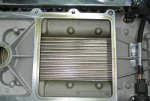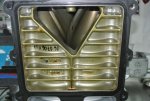OIL SEPERATOR CAN PCV
- Thread starter Simon
- Start date
You are using an out of date browser. It may not display this or other websites correctly.
You should upgrade or use an alternative browser.
You should upgrade or use an alternative browser.
I've got a new one that matches our car from Guyett Performance $495 shipped
I am interested if OP isn't.
How does a guy decide if the car really needs one of these? Is there a certain amount of boost/power that makes it more important than for a stock set up?
How does a guy decide if the car really needs one of these? Is there a certain amount of boost/power that makes it more important than for a stock set up?
You need one....PERIOD.
How does a guy decide if the car really needs one of these? Is there a certain amount of boost/power that makes it more important than for a stock set up?
Ford modular motors are known to pass quite a bit of oil through the passenger side PCV hose.
I've got a new one that matches our car from Guyett Performance $495 shipped
PM sent
The Grey Ghost
GT Owner
I have that one. Fits and works perfect. Looks OEM.
I'll give a second thumbs up for the Guyett model. Been very happy with mine.
BlackICE
GT Owner
I'll give a second thumbs up for the Guyett model. Been very happy with mine.
:agree:
Why? I did the track day at Rally 12 and did not lose any oil. I can't see that I would drive it that hard on the street.You need one....PERIOD.
For those owners have a car that is using oil - *maybe* a catch can will help if that oil is from classical blow-by (as opposed to leaking, etc.)
Just ask yourself one question.... if you are not losing any oil, what are you going to catch?
Too many people are giddy that they're catch-can is working when they pull a couple of tablespoons of black murky liquid from them. Many times this is mostly comprised of a complex substance called H2O and would be burned without consequence by the engine. On a stock GT - or one with a common pulley/tune kit, my opinion is that there is absolutely no need. No doubt, someone will be jumping in to say how wrong I am. Don't bother. If you want me to show the calculations of how silly they are, I can.
Just ask yourself one question.... if you are not losing any oil, what are you going to catch?
Too many people are giddy that they're catch-can is working when they pull a couple of tablespoons of black murky liquid from them. Many times this is mostly comprised of a complex substance called H2O and would be burned without consequence by the engine. On a stock GT - or one with a common pulley/tune kit, my opinion is that there is absolutely no need. No doubt, someone will be jumping in to say how wrong I am. Don't bother. If you want me to show the calculations of how silly they are, I can.
For those owners have a car that is using oil - *maybe* a catch can will help if that oil is from classical blow-by (as opposed to leaking, etc.)
Just ask yourself one question.... if you are not losing any oil, what are you going to catch?
Too many people are giddy that they're catch-can is working when they pull a couple of tablespoons of black murky liquid from them. Many times this is mostly comprised of a complex substance called H2O and would be burned without consequence by the engine. On a stock GT - or one with a common pulley/tune kit, my opinion is that there is absolutely no need. No doubt, someone will be jumping in to say how wrong I am. Don't bother. If you want me to show the calculations of how silly they are, I can.
:bow OK, fair enough Kendall.....I'm silly.
I will strive to refrain from posting and/or purchasing anything and wait for your future pronouncements forthwith. Will these edicts be coming once a month, a quarter, yearly, or simply your whimsy?
This thread has some good reference pictures:
http://www.fordgtforum.com/forums/s...cooler-Oil-Vapor?highlight=Oil+on+intercooler


http://www.fordgtforum.com/forums/s...cooler-Oil-Vapor?highlight=Oil+on+intercooler


Will these edicts be coming once a month, a quarter, yearly, or simply your whimsy?
My pleasure. I can offer a subscription plan for any of the above. Just a matter of how much wisdom you can absorb.
As an advocate, why don't you enlighten us on how much "oil" you catch across what mileage interval?
twobjshelbys
GT Owner
Why? I did the track day at Rally 12 and did not lose any oil. I can't see that I would drive it that hard on the street.
I concur. I had one on my supercharger in my Mustang and after 8000 miles of spirited driving it had only a teaspoon. It amounted to a few drops every thousand miles. The speed shop guy at Shelby American said it this way: If you have anything more than a very small amount in it then you have a bigger problem. Maybe that's OK. But if you're getting lots of engine oil blow-by certainly there will be other indications.
It won't be in the supercharger, it will be in the intercooler. I had to pull my supercharger to rebuild the bearings and the supercharger and intercooler was clean.
Think about it: If it were essential then wouldn't Ford have put it on there to begin with?
We've pulled many GT Superchargers. (A prerequisite to installing a pulley/tune which is likely one of the most popular GT mods in GT-land.) Some look like the pic that sinovac posted, some are fairly dry and most are in-between.
But let's look at the that catch-can "results" referenced in that older thread. In that picture... it sure doesn't look like 1/3 cup, but let's pretend that it is. What horrors are we really subjecting the engine to?
Author of that thread "Caught" 1/3 of a cup across 5000 miles
1 cup = 48 teaspoons; 1/3 cup = 16 teaspoons
1 Teaspoon = ~100 drops; 16 teaspoons = 1600 drops
1600 drops across 5000 miles = 1600/5000 = 0.32 drops per mile (oh the tragedy!)
Assumption: GT is averaging 16 mpg
1 mile = 1/16 gallons of gasoline is consumed
128 ounces per gallon
1/16 gallon = 8 ounces
8 ounces = 48 teaspoons
1 teaspoon = 100 drops
Conclusion: GT @ 16 mpg (avg) burns approximately 4800 "drops" of gasoline per mile
While the engine is consuming 4800 drops of fuel/mile, the catch can "saved" the engine from having to ingest 0.32 drops of blow-by.
Viewed differently, had this been forced down the throat of the engine, compared to fuel being consumed, it represents 0.32/4800 = .0000666; or .0067%
Not all that compelling to me to spend money to solve a problem that simply doesn't exist.
(I think the argument changes when you talk about bigger boost from Whipples or turbos as the added pressures will definitely increase blow-by and it *may* get it into the range where you want to be pro-active about it.)
But let's look at the that catch-can "results" referenced in that older thread. In that picture... it sure doesn't look like 1/3 cup, but let's pretend that it is. What horrors are we really subjecting the engine to?
Author of that thread "Caught" 1/3 of a cup across 5000 miles
1 cup = 48 teaspoons; 1/3 cup = 16 teaspoons
1 Teaspoon = ~100 drops; 16 teaspoons = 1600 drops
1600 drops across 5000 miles = 1600/5000 = 0.32 drops per mile (oh the tragedy!)
Assumption: GT is averaging 16 mpg
1 mile = 1/16 gallons of gasoline is consumed
128 ounces per gallon
1/16 gallon = 8 ounces
8 ounces = 48 teaspoons
1 teaspoon = 100 drops
Conclusion: GT @ 16 mpg (avg) burns approximately 4800 "drops" of gasoline per mile
While the engine is consuming 4800 drops of fuel/mile, the catch can "saved" the engine from having to ingest 0.32 drops of blow-by.
Viewed differently, had this been forced down the throat of the engine, compared to fuel being consumed, it represents 0.32/4800 = .0000666; or .0067%
Not all that compelling to me to spend money to solve a problem that simply doesn't exist.
(I think the argument changes when you talk about bigger boost from Whipples or turbos as the added pressures will definitely increase blow-by and it *may* get it into the range where you want to be pro-active about it.)


